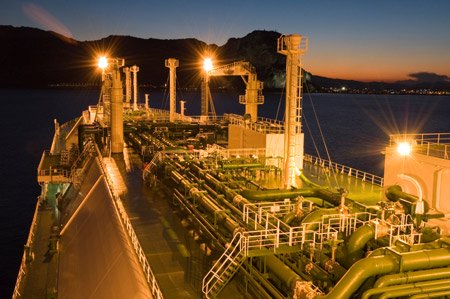
The use of LNG as a transport fuel is garnering more attention as the number of LNG carriers worldwide goes up
The number of vessels for transporting liquefied natural gas (LNG) has grown tremendously in the last few years in line with rising demand for the super-chilled gas to feed Asia’s growing energy needs.
Simultaneously, the use of LNG as a lower-carbon fuel for LNG ships has also garnered more attention, said two members of the shipping industry at the Gas Asia Summit at SIEW 2013.
At a panel discussion on “Meeting gas demand and LNG bunkering in Southeast Asia”, Mr Suruyan Wirya-Simunovic, the General Manager of Mitsui O.S.K Bulk Shipping (Singapore), shared a few statistics on the LNG Shipbuilding industry. Mitsui O.S.K Bulk Shipping (Singapore) is a leader globally in the management and operations of LNG carriers, and currently has 70 LNG carriers in its fold. In the coming years, the total number of LNG carriers is tipped to reach 467 worldwide, said Mr Wirya-Simunovic, noting that the average size of LNG carriers had also expanded.
Mr Wirya-Simunovic said that current ship-building capacity was sufficient to build the carriers, “if we take all the shipyards in Korea, Japan, China into consideration.” However, given the more stringent emissions requirements globally, initial investment costs for LNG carriers has also risen as there is growing interest in using LNG as a transport fuel for these large carriers. As a result, LNG tanks have to be installed for the carriers, the crew has to be taught how to manage a carrier fuelled by LNG, and the vessel owner also has to take into account the higher prices of LNG in Asia “There is quite a lot of downside risk,” stated Mr Wirya-Simunovic. Nonetheless, he added, there were incentives such as favorable tax treatments and government support for the cause.
Speaking after him, Mr Douglas Raitt, of Lloyd’s Register, a maritime classification society and independent risk management organisation, said that at the moment, not many large ships used alternative fuels such as LNG.
Mr Raitt, Lloyd’s Global Fuel Oil Bunker Analysis and Advisory Service Manager, said that the key for LNG to be widely used as a fuel for LNG carriers would be to leverage the costs of LNG versus conventional fuel costs and sources. LNG bunkering infrastructure would also need to be more widely developed, and other issues spanning safety and standards of usage would also have to be considered.
“Gas pricing is not global at the moment and is not really going to be uniform anytime soon, so the pricing dynamic will continue to drive investment decision choices,” he said.
By : Natalya Marusich, INSEAD